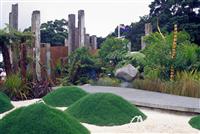Want to Design Gardens?
Want to set up a small part time business and grow it into something full time and profitable?
 This course has done just that for hundreds of others before you.
This course has done just that for hundreds of others before you.
Be a garden designer!
- Developed by a team of successful garden designers from both Australia and the UK.
- Broader than other courses which are developed and sometimes focussed on just one country.
- Access experienced and qualified tutors in both the UK and Australia.
This course has operated for many years (with regular updates) as an effective training program for people working, or wishing to work, in the landscape industry; either in their own business, or at a supervisory level for for a boss.
The course develops the students design skills, as well as basic knowledge in other areas of concern to the landscaper (e.g. horticultural practices, management, plant identification and use, and marketing). On completion of this course the student should be able to draw landscape plans, compile specifications, and prepare cost estimates. There are thirty lessons taking around 600 to 700 hours to complete.
Exams: There are two exams for the course; one after lesson 15, and the second one at the conclusion of the course. Exams are arranged at a time and location to suit you. Please note additional fees apply for each exam.